The horse bunk feeder market is estimated to be valued at USD 669.2 million in 2025 and is projected to reach USD 1256.2 million by 2035, registering a compound annual growth rate (CAGR) of 6.5% over the forecast period. The market demonstrates robust expansion driven by commercial equine facility growth, horse welfare optimization, and feeding efficiency demands that require specialized equipment capable of reducing hay waste while promoting natural feeding behaviors and minimizing competition-related stress among horses in group feeding environments. Equestrian facilities implement bunk feeding systems that accommodate multiple horses simultaneously while controlling hay consumption rates and preventing selective feeding patterns that could result in nutritional imbalances across individual animals within herd settings. The technology's evolution toward adjustable opening designs and anti-waste features creates demand for feeders that optimize forage utilization while supporting digestive health through extended feeding periods that mimic natural grazing behaviors.
Commercial boarding facilities represent the dominant consumption segment where bunk feeders enable efficient hay distribution across large horse populations while reducing labor requirements and feed waste that directly impacts operational profitability and environmental sustainability. Stable managers specify feeder configurations that accommodate different hay types including square bales, round bales, and loose hay while maintaining accessibility for horses of varying sizes and feeding preferences. Quality assurance protocols emphasize construction durability, safety design features, and weather resistance that ensure reliable operation under demanding outdoor conditions where equipment exposure to moisture and temperature variations affects performance and longevity.
Professional breeding operations demonstrate increasing adoption of specialized bunk systems designed for broodmares, foals, and stallions that require controlled feeding environments and nutritional monitoring capabilities throughout critical reproductive and developmental periods. Veterinary nutrition specialists recommend feeding systems that promote slower consumption rates and reduce respiratory irritation from dust and fine particles commonly associated with conventional feeding methods. Pasture management integration enables seasonal feeding supplementation that supports grass-based nutrition programs while providing backup feeding capabilities during drought conditions or winter months when natural forage becomes unavailable.
Supply chain considerations emphasize material selection and manufacturing techniques that ensure bunk feeder longevity under aggressive horse behavior including biting, pawing, and kicking that could damage feeding equipment and create safety hazards for animals and handlers. Galvanized steel and powder-coated finishes provide corrosion resistance while smooth surface designs eliminate sharp edges and potential injury risks during feeding activities. Distribution networks prioritize technical support and installation assistance that ensure proper feeder placement and assembly procedures necessary for safe operation and maximum effectiveness.
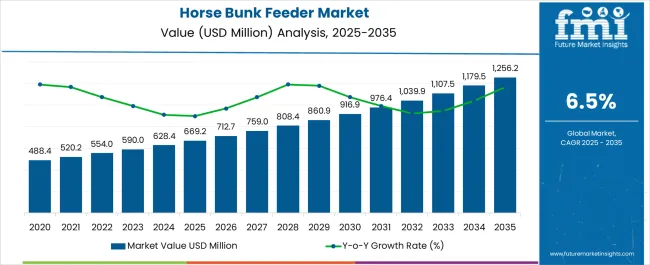
| Metric | Value |
|---|---|
| Horse Bunk Feeder Market Estimated Value in (2025 E) | USD 669.2 million |
| Horse Bunk Feeder Market Forecast Value in (2035 F) | USD 1256.2 million |
| Forecast CAGR (2025 to 2035) | 6.5% |
The horse bunk feeder market is experiencing steady growth due to rising awareness around animal health management, increasing equestrian activities, and the emphasis on efficient feeding practices. The need for durable, safe, and easy-to-clean feeding solutions is driving demand, particularly as horse owners and commercial stables focus on reducing feed wastage and ensuring animal well-being.
Advances in material innovation and ergonomic design have further enhanced the functionality of bunk feeders, making them suitable for diverse equine environments. Growing adoption of direct-to-customer sales channels and digital platforms is enabling broader product accessibility.
Additionally, increasing investment in sustainable and lightweight feeder solutions is anticipated to create new opportunities for manufacturers. The market outlook remains positive as equestrian sports, recreational horse ownership, and commercial breeding facilities continue to expand globally.
The market is segmented by Material, Length, and Sales Channel and region. By Material, the market is divided into Plastic and Metal. In terms of Length, the market is classified into Below 5 Feet, 5 to 10 Feet, and Above 10 Feet. Based on Sales Channel, the market is segmented into Direct Sales and Retail Sales. Regionally, the market is classified into North America, Latin America, Western Europe, Eastern Europe, Balkan & Baltic Countries, Russia & Belarus, Central Asia, East Asia, South Asia & Pacific, and the Middle East & Africa.
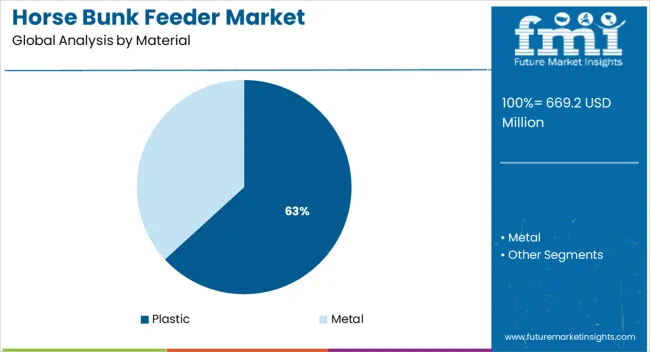
The plastic material segment is expected to hold 63.20% of the overall market revenue by 2025, making it the leading category. Its dominance is supported by the durability, lightweight nature, and cost efficiency of plastic compared to traditional materials.
Resistance to rust, ease of cleaning, and suitability for both indoor and outdoor environments have strengthened its appeal among horse owners. Additionally, the availability of UV-stabilized and weather-resistant plastic bunk feeders has further enhanced their longevity.
As end users increasingly value affordability and practicality, plastic continues to be the preferred choice in the horse bunk feeder market.
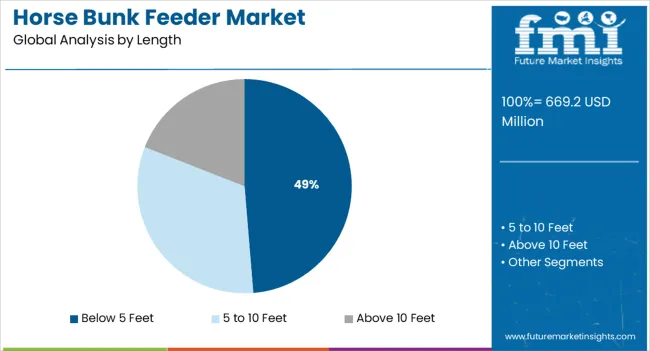
The below 5 feet segment is projected to represent 48.70% of market revenue by 2025, making it the most prominent length category. This growth is attributed to its suitability for small-scale stables and individual horse owners who require compact feeding solutions.
The shorter design supports ease of installation, mobility, and space efficiency within barns and outdoor setups. Additionally, its cost-effectiveness and compatibility with various stable designs make it a favorable option.
With rising demand for practical and space-saving feeder systems, the below 5 feet segment maintains a strong position within the market.
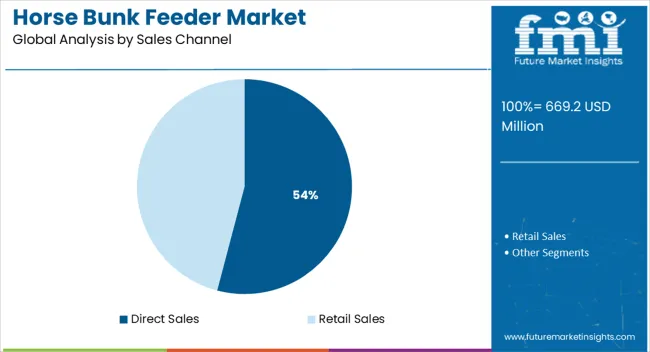
The direct sales channel segment is anticipated to contribute 54.10% of the total revenue by 2025, positioning it as the leading distribution channel. Its prominence is driven by the ability of manufacturers and suppliers to build strong customer relationships, offer product customization, and ensure better after-sales service.
Direct sales provide greater transparency in pricing, improved trust, and faster product delivery compared to indirect channels.
As equine owners increasingly prefer direct engagement with suppliers for tailored solutions, the direct sales segment has emerged as the dominant sales channel in the horse bunk feeder market.
Historical Period (2020 to 2025)
| Attributes | Details |
|---|---|
| CAGR | 5.8% |
| 2020 Value | 394.6 million |
| 2025 Value | 554 million |
The market has grown and evolved over time as technology and understanding of horse nutrition have advanced. In the past, horse bunk feeders were relatively simple and basic in design. Now, however, with the advancement of technology and research in horse nutrition, horse bunk feeders have become more refined. Certain feeders offer more advanced features such as self-dispensing technology, adjustable feed flow settings, built-in cameras and monitoring systems, anti-tip designs and so on. The market has also grown as the interest in horseback riding has increased.
Forecast Period (2025 to 2035)
| Attributes | Details |
|---|---|
| CAGR | 6.5% |
| 2025 Value | 590 million |
| 2035 Value | 1,108 million |
The future prospects of the market are likely to be positive as the demand for horse feeders is expected to increase during the forecast period. The increasing popularity of horseback riding and horse ownership coupled with the growing awareness of the importance of proper nutrition for horses are expected to drive the market growth. In the upcoming years, manufacturers are likely to develop more advanced horse bunk feeders with features such as automation, remote monitoring and data collection capabilities. Moreover, the increasing awareness about animal welfare is also anticipated to drive market growth.
These factors are anticipated to support about a 1.9X increase in the horse bunk feeder market between 2025 and 2035. According to FMI analysts, the market is projected to be worth USD 1,108 million by the end of 2035.
Several important factors that have been discovered are expected to lead to a large expansion of the global market throughout the projected period. In addition to market-shaping variables, FMI researchers examined alluring possibilities and limiting aspects that are likely to affect the sales of horse bunk feeders.
Market Drivers: The market is driven by several factors including:
Market Restraints: Certain potential restraints for the market include:
Market Opportunities: Key opportunities of the market include:
With the growing focus on sustainability, eco-friendly materials are becoming increasingly popular among both manufacturers and consumers. This has led to a shift in the market towards sustainable options such as plastic-free feeders made from different metals. Moreover, metal horse bunk feeders are durable and long-lasting as well as can withstand the elements better than plastic feeders. These feeders are also resistant to rust, corrosion and other forms of wear and tear.
These feeders also tend to be more secure and chew-resistant. This is important for preventing horses from getting into the feed and potentially injuring themselves. Furthermore, metal bunk feeders are weather resistant and can survive dangerous weather conditions like heavy rain and extreme heat. Horse breeders also prefer these metal feeders since they are easy to clean and disinfect. This is crucial for marinating good hygiene and preventing the spread of disease.
The direct sales segment dominated the market in 2025 and is likely to maintain its position during the forecast period. Direct-to-customer sales are more profitable than retail sales for horse bunk feeders for several reasons:
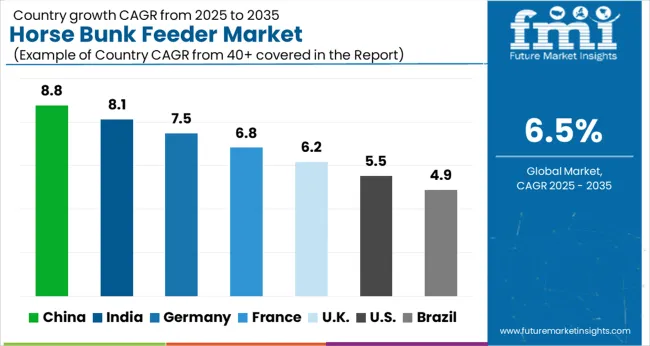
| Country | United States |
|---|---|
| Market Share (2025) | 30.7% |
| Market Value (2025) | USD 170 million |
| Country | Germany |
|---|---|
| Market Share (2025) | 19.9% |
| Market Value (2025) | USD 110.1 million |
| Country | United Kingdom |
|---|---|
| Market Share (2025) | 9.8% |
| Market Value (2025) | USD 54.3 million |
| Country | China |
|---|---|
| Market Share (2025) | 9.4% |
| Market Value (2025) | USD 52 million |
| Country | Japan |
|---|---|
| Market Share (2025) | 3.9% |
| Market Value (2025) | USD 21.7 million |
| Country | India |
|---|---|
| Market Share (2025) | 3.9% |
| Market Value (2025) | USD 21.5 million |
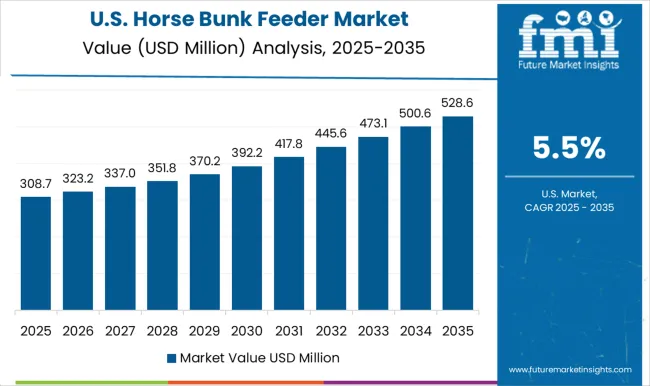
A sizeable portion of the equine sector is found in the United States. As it offers a balanced diet and crucial elements for their health and performance, feeding feeds and grains to horses is a widespread practice among horse owners. Slow feeders have been more prominent in the nation over the past few years. The American Horse Council estimates that the horse business generates USD 122 billion in revenue. To assure durability and safety, manufacturers in the United States are creating feeders from eco-friendly materials.
The United States horse bunk feeder market is growing steadily as more people are becoming interested in horse breeding and owning horses for leisure. The market is highly competitive, with the existence of many key companies in the market. They offer similar products at different price points. Manufacturers in the country also offer custom-made feeders to cater to the specific needs of horse owners.
A huge financial industry in the United Kingdom is the equestrian industry. The sector offers a broad array of services, such as horse racing, breeding, exhibition, and recreational pursuits like riding, pulling a carriage, and trekking. Furthermore, horse ownership and breeding are becoming increasingly popular across the nation. Different types of bunk feeders, including hay feeders, hay racks, and hay nets, have seen an increase in popularity in recent years.
Europe is renowned for being one of the world's top environmentally conscious countries. Horse owners are becoming more aware of the materials in the products they buy for their horses. As a result, several producers are now providing feeders made of recycled materials or employing more environmentally friendly production techniques. Additionally, the government's existing rules and directives for horse feeding have an impact on the market. With a CAGR of 7.0%, the United Kingdom horse bunk feeder market is therefore predicted to reach USD 1256.2 million by 2035.

Given the increasing popularity of equestrian sports like horseback riding, the market in Germany is a niche but expanding business. With over 2 million horses and ponies kept for leisure and competition, Germany is home to a sizable equestrian sector. Owing to this, there is a demand for premium horse feeders that can effectively and efficiently provide feed.
The market is maturing since discretionary income is booming in the country and equine nutrition and well-being are becoming widely understood. The key players in the German horse bunk feeder market offer feeders that are designed to slow down the rate of eating, helping to reduce the risk of choking and colic in horses.
Chinese horse bunk feeder market is relatively small but is growing rapidly at present as more people are becoming interested in horse breeding. Horse breeding in China has traditionally been focused on producing strong workhorses. However, in recent years, there has been a growing interest in equestrian activities like horse racing and show jumping. This is one of the primary factors propelling the market's expansion in China. The market is therefore anticipated to reach USD 86.4 million by 2035, reflecting a CAGR of 5.2%.
To enhance the nation's overall sporting prowess and promote tourism, the Chinese government has also been encouraging equestrian sporting events. This has caused additional equestrian centers to be built and the proportion of horses in China to rise. Horse bunk feeder demand has grown as a result of both of these events. The expanding e-commerce industry in China is also having an impact on the market for horse bunk feeders. Owing to an increase in Chinese customers using the internet to buy products and services, sales of horse bunk feeders online have been rising over the past several years.
In comparison to other horse goods or services, the market in Japan is rather limited. A committed group of horse owners and trainers still places a high value on the health and welfare of their equine companions and is prepared to spend money on high-quality feeds. The Japanese Thoroughbred, a type renowned for its speed and endurance, is one of several horse breeds that can be found in Japan. These horses are frequently employed in the lucrative Japanese horse racing business.
The Japanese horse bunk feeder market is also influenced by changes in horse ownership and the horse racing industry. The number of horse owners has been steadily decreasing in recent years. This has led to a decline in the overall demand for horse feeders. However, the popularity of horse racing and other equestrian sports has been increasing, which has helped to offset this decline. The market in Japan is dominated by domestic manufacturers, with the presence of a few international manufacturers.
The Indian horse bunk feeder market is growing significantly when it comes to CAGR. Horse breeding and ownership are a tradition in India, with horses being used for transportation, farming, and sports such as horse racing. The market is therefore driven by the increasing popularity of horse sports as well as a growing number of equestrian clubs and training centers in the country. Horse racing is a popular sport in India and has a rich history dating back to the 18th century.
Horse racing as a sport is governed by several organizations throughout the year. This has led to an increase in the number of horse breeders and owners in the country. This, in turn, has increased the demand for horse bunk feeders as these can feed multiple horses at a time. Numerous businesses in India produce and distribute horse bunk feeders despite the industry's low magnitude. Therefore, a valuation of USD 44.8 million is projected for the Indian market by 2035, with a CAGR of 7.6%.
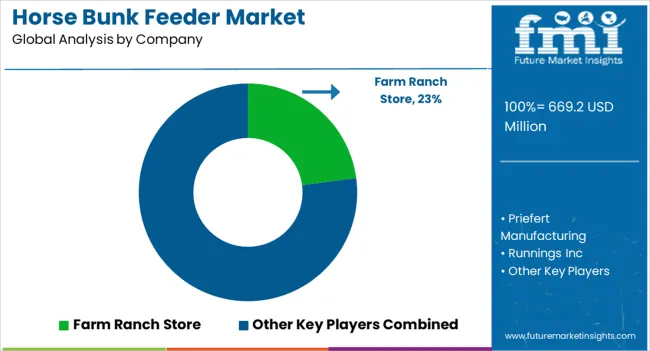
The horse bunk feeder market is shaped by established agricultural equipment manufacturers and regional suppliers offering durable, weather-resistant feeding systems designed for farms, ranches, and equestrian facilities. Farm Ranch Store and Tractor Supply maintain leading positions through wide retail distribution and extensive product ranges that cater to both small and large-scale horse owners. Their feeders are valued for easy accessibility, corrosion resistance, and suitability for various feed types.
Priefert Manufacturing and Tarter dominate the premium segment, offering heavy-duty steel bunk feeders engineered for stability, animal safety, and long service life. These companies leverage strong brand recognition and nationwide dealer networks to maintain consistent market visibility. Behlen Country and Behlen Mfg. Co. supply galvanized and polyethylene models optimized for outdoor durability and ease of maintenance, appealing to both professional stables and hobby farms.
Runnings Inc. and AGI Products focus on affordable, functional feeders distributed through regional networks and farm supply outlets. Hutchison Inc. provides customizable metal and poly bunk feeders tailored to ranching operations, emphasizing build strength and feeding efficiency. FeedsForLess.com supports the online retail segment, offering a variety of bunk feeder designs that meet diverse consumer budgets and preferences.
| Items | Values |
|---|---|
| Quantitative units (2025) | USD 669.2 million |
| Material | Plastic; Metal |
| Length | Below 5 feet; 5 to 10 feet; Above 10 feet |
| Sales channel | Direct sales; Retail sales; e-commerce implied |
| Regional coverage | North America; Latin America; Western Europe; Eastern Europe; Balkan & Baltic; Russia & Belarus; Central Asia; East Asia; South Asia & Pacific; Middle East & Africa |
| Key countries covered | United States; Germany; United Kingdom; China; Japan; India; plus broader 60+ country splits in full dataset |
| Top companies profiled | Farm Ranch Store; Priefert Manufacturing; Runnings Inc.; AGI Products; Tractor Supply; Behlen Country; Behlen Mfg. Co.; Hutchison Inc.; FeedsForLess.com; Tarter |
| Additional attributes | Dollar sales by material, length, channel, and region; rising adoption of plastic bunk feeders; focus on sustainability, IoT readiness, farm modernization, animal welfare, direct sales growth, and R&D in durable materials |
The global horse bunk feeder market is estimated to be valued at USD 669.2 million in 2025.
The market size for the horse bunk feeder market is projected to reach USD 1,256.2 million by 2035.
The horse bunk feeder market is expected to grow at a 6.5% CAGR between 2025 and 2035.
The key product types in horse bunk feeder market are plastic and metal.
In terms of length, below 5 feet segment to command 48.7% share in the horse bunk feeder market in 2025.
x






Full Research Suite comprises of:
Market outlook & trends analysis
Interviews & case studies
Strategic recommendations
Vendor profiles & capabilities analysis
5-year forecasts
8 regions and 60+ country-level data splits
Market segment data splits
12 months of continuous data updates
DELIVERED AS:
PDF EXCEL ONLINE
Horse Drawn Farming Equipment Market Size and Share Forecast Outlook 2025 to 2035
Horse Corral Panels Market Size and Share Forecast Outlook 2025 to 2035
Horse Insurance Market Size and Share Forecast Outlook 2025 to 2035
Horse Stable Supplies Market Size and Share Forecast Outlook 2025 to 2035
Horse Chestnut Seed Extract Market Size, Growth, and Forecast for 2025–2035
Horse Riding Equipment Market Analysis – Growth & Forecast 2025-2035
Horse Grain Feeders Market Size and Share Forecast Outlook 2025 to 2035
African Horse Sickness Treatment Market
Compound Horse Feedstuff Market Analysis by Feed Type, Horse Activity, and Ingredient Composition Through 2035
Industrial Fractional Horsepower Motors Market Analysis by End-user and Region: Forecast for 2025 to 2035
LNG Bunkering Market Size and Share Forecast Outlook 2025 to 2035
Feeder Container Market Size and Share Forecast Outlook 2025 to 2035
Hog Feeder Market Size and Share Forecast Outlook 2025 to 2035
Belt Feeders Market Size and Share Forecast Outlook 2025 to 2035
Weft Feeder Market Trend Analysis Based on Type, Operation, Application, and Region 2025 to 2035
Pump Feeders Market Growth - Trends & Forecast 2025 to 2035
Part Feeder Market
Cattle Feeder Panels Market Size and Share Forecast Outlook 2025 to 2035
Cattle Feeder Market Size and Share Forecast Outlook 2025 to 2035
Chicken Feeder and Drinkers Market Size and Share Forecast Outlook 2025 to 2035

Thank you!
You will receive an email from our Business Development Manager. Please be sure to check your SPAM/JUNK folder too.
Chat With
MaRIA